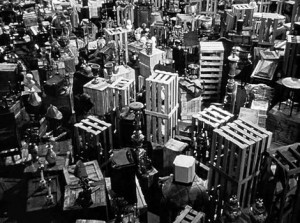In today’s Wall Street Journal “Sightings” column I write about Henry Folger, who amassed the collection that became the Folger Shakespeare Library, and about art collectors in general. Might they perhaps all be slightly loony? Here’s an excerpt.
* * *
When I started buying fine-art prints, a critic told me, “You won’t be a real art collector until you own more pieces than you have room to hang.” Sure enough, there comes a point in the lives of many collectors when the urge to accumulate overwhelms the passion to appreciate. That’s what happened to Henry Folger, the founder of the Folger Shakespeare Library, whose passion for Shakespeare is chronicled in Andrea Mays’ “The Millionaire and the Bard: Henry Folger’s Obsessive Hunt for Shakespeare’s First Folio,” which will be published in May by Simon & Schuster.
Folger was a self-made millionaire who in his youth became fascinated by Shakespeare’s plays. Working in tandem with his wife Emily, he started collecting early editions of Shakespeare’s writings in 1889, when he was still a salaried executive who didn’t make enough money to fling it around. But he spent lavishly anyway, and by the time he died in 1930, the Folgers had assembled a huge collection that included 79 copies of the “First Folio,” the earliest published edition of Shakespeare’s plays, and were building a museum to house it in Washington, D.C.
 Even after Henry became rich, the Folgers lived simply in a rented Brooklyn house. Instead of trying to buy their way into society, they sank their money into the collection and, later, the building where it can now be viewed by the public. As a result, Ms. Mays writes, they were never able to fully appreciate their holdings: “Once Henry and Emily had stuffed the rooms and closets of their modest home full of Shakespeariana, they had to banish the bulk of their treasures to warehouses, perhaps never to be seen by them again.”
Even after Henry became rich, the Folgers lived simply in a rented Brooklyn house. Instead of trying to buy their way into society, they sank their money into the collection and, later, the building where it can now be viewed by the public. As a result, Ms. Mays writes, they were never able to fully appreciate their holdings: “Once Henry and Emily had stuffed the rooms and closets of their modest home full of Shakespeariana, they had to banish the bulk of their treasures to warehouses, perhaps never to be seen by them again.”
That’s a symptom of Collector’s Mania, one of the most mysterious diseases known to man. Its best-known victim was Charles Foster Kane, the fictional anti-hero of “Citizen Kane,” who amassed what the film describes as “a collection of everything so big it can never be catalogued or appraised, enough for 10 museums.” By the end of his life, Kane was buying sculptures without bothering to take them out of their shipping crates. Many real-life gilded-age American millionaires who collected art in bulk, like William Randolph Hearst (Kane’s model) and J.P. Morgan, did so in the same obsessive and puzzling way….
Absent the ulterior motives of personal glory or pecuniary profit, why would anyone who claims to love art buy expensive works of art, then put them in storage? What kind of love is that? The only good reason I can think of to buy a sculpture is to be able to look at it every day….
* * *
Read the whole thing here.
